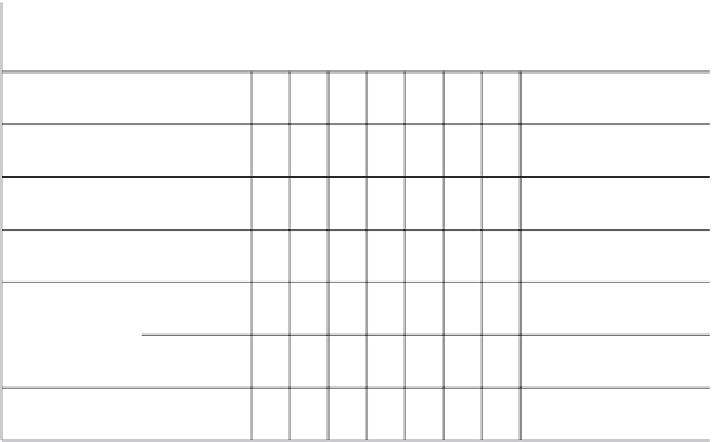Environmental Engineering Reference
In-Depth Information
Modulus of deformation E, 10
5
kg /cm
2
12 3 456 7
Elastic wave velocity test
(cylindrical specimen)
Wet condition
Wet condition
σ
Uniaxial compression test
(cylindrical specimen)
= 0~100 kg/cm
2
Chamber diameter = 2 m
σ
Water chamber test in situ
= 20~30 kg/cm
2
Plate-jack test
(100 cm square)
σ
= 50~60 kg/cm
2
Hydrostatic
pressure
σ
= 50~75 kg/cm
2
Triaxial
compression
test in situ
Uniaxial
pressure
σ
= 80~100 kg/cm
2
Plate-jack test
(30-cm disk)
= 50~60 kg/cm
2
σ
FIGURE 3.74
Deformation moduli obtained by various types of tests in a jointed granite. (From Hibino, S. et al.,
Proceedings
of the International Symposium on Field Measurements in Rock Mechanics,
Zurich, Vol. 2, 1977, pp. 935-948. With
permission.)
Measuring Rock Quality
Rock-quality designation
(RQD) as determined from core examination (see
Section 2.4.5)
provides an index to rock quality.
Modulus ratio E
t50
/
U
ult
is defined by Deere and Miller (1966) as the ratio of the tangent
modulus
E
t50
taken at a stress level of one half the ultimate strength, to the uniaxial com-
pressive strength
U
ult
as obtained by laboratory test. It was selected as a basis for the engi-
neering classification of intact rock (see
Section 5.2.7)
because it is related to deformation and
strength and provides a measure of material anisotropy. Low modulus values result from
large deformations caused by the closure of foliation and bedding planes; high modulus val-
ues are representative of material with interlocking fabric and little or no anisotropy.
Modulus ratio E
r
/
E
t50
is defined (Coon and Merritt, 1970) as the ratio of the
in situ
static
modulus
E
r
to the intact static modulus
E
t50
.
Velocity ratio V
F
/
V
L
is defined (Coon and Merritt, 1970) as the ratio of the field P-wave
velocity, as determined by uphole or crosshole seismic methods or the 3-D velocity logger,
to the laboratory P-wave velocity as determined by the resonant column device or ultra-
sonic testing (ASTM 2845). The velocity ratio approaches unity in high-quality massive
rocks with few joints.
Velocity index
(
V
F
/
V
L
) is defined (Coon and Merritt, 1970) as the square of the ratio of the
field seismic velocity to the laboratory seismic velocity, or the square of the ratio of the
in
situ
velocity to the intact velocity. The velocity ratio is squared to make the velocity index
equivalent to the ratio of the dynamic moduli.
Modulus Reduction Factor
β
Proposed by Deere et al. (1967), the modulus reduction factor
expresses the extent to
which
E
r
is always lower than
E
seis
because of the short duration pulse and low stress level
of the
in situ
seismic test. It is given as
β
β
E
r
/
E
seis
(3.62)








